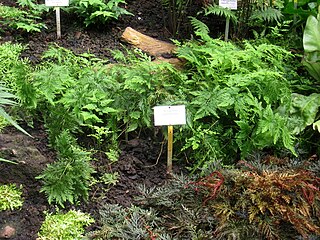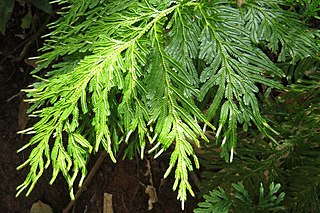
Selaginella is the sole genus in the family Selaginellaceae, the spikemosses or lesser clubmosses, a kind of vascular plant.

Pinctada is a genus of saltwater oysters, marine bivalve mollusks in the family Pteriidae. These pearl oysters have a strong inner shell layer composed of nacre, also known as "mother of pearl".

Selaginella bryopteris (Devanagari:संजीवनी) is a lithophytic plant that is native to India. It is used medicinally in India and is one of the plants that is considered as a candidate to be the sanjeevani plant.

Selaginella lepidophylla, also known as a resurrection plant, is a species of desert plant in the spikemoss family (Selaginellaceae). It is native to the Chihuahuan Desert of North America and Mexico. S. lepidophylla is renowned for its ability to survive almost complete desiccation. Resurrection plants are vascular rooted plants capable of surviving extreme desiccation, then resuming normal metabolic activity upon rehydration. The plant's hydro-responsive movements are governed by stem moisture content, tissue properties and a graded distribution of lignified cells affecting concentric stem stiffness and spiraling. During dry weather in its native habitat, its stems curl into a tight ball, uncurling only when exposed to moisture.

Selaginella apoda, commonly known as meadow spikemoss, is a perennial lycophyte native to much of the eastern United States and parts of northeastern Mexico. The life cycle is the shortest of the genus Selaginella, as well as one of the shortest among the lycophytes. Selaginella apoda is found primarily in damp soils in habitats such as swamps, wet fields, open woods and along stream banks. Selaginella apoda presents the potential for case studies involving the plant's adaptability to environmental toxins. A lowland plant, it has only been recorded at elevations below 100 meters. It is closely related to Selaginella eclipes and S. ludoviciana, with both of which it has been reported to form hybrids. This group is characterized by relatively flat strobili and large megasporophylls which occur in the same plane as the lateral leaves.

Selaginella selaginoides is a non-flowering plant of the spikemoss genus Selaginella with a wide distribution around the Northern Hemisphere. It resembles a moss in appearance but is a vascular plant belonging to the division Lycopodiophyta. It has a number of common names including lesser clubmoss, club spikemoss, northern spikemoss, low spikemoss and prickly mountain-moss. This plant has one close relative, Selaginella deflexa, native to Hawaii. These two plants form a small clade that is sister to all other Selaginella species.

Selaginella kraussiana is a species of vascular plant in the family Selaginellaceae. It is referred to by the common names Krauss' spikemoss, Krauss's clubmoss, or African clubmoss, and is found naturally in parts of Sub-Saharan Africa and in Macaronesia. It is sometimes given the misnomer of “peacock fern”, due to its lacy leaf structure, despite having no relation to actual ferns; rather, it belongs to the very ancient lineage of plants known as the clubmosses.

Selaginella serpens is a species of plant in the family Selaginellaceae: found mostly in the Caribbean.

Selaginella pulcherrima is a species of plant in the family Selaginellaceae.

Selaginella poulteri is a species of plant in the family Selaginellaceae.

Selaginella elmeri is a species of plant in the Selaginellaceae family.

Selaginella umbrosa is a species of plant in the Selaginellaceae family.

Olivierus martensii is a species of scorpion in the family Buthidae. Its common names include Chinese scorpion, Manchurian scorpion, Chinese armor-tail scorpion and Chinese golden scorpion. Despite its common name, this scorpion is not only found in Manchuria or China, but also in Mongolia and Korea. The record from Japan is doubtful. Its preferred habitat is warm, dry areas with little vegetation. O. martensii can grow to about 6 centimetres (2.4 in) long, with females usually slightly larger, and has a life-span of about 4 to 6 years.

Selaginella denticulata, or Mediterranean clubmoss, is a non-flowering plant of the spikemoss genus Selaginella with a wide distribution around the Northern Hemisphere.

Selaginella tamariscina is a species of plant in the Selaginellaceae family, endemic to China, India, Japan, Korea, Philippines, Russia (Siberia), Taiwan, and northern Thailand. It is an evergreen perennial growing to 45 cm in height. It is often used as an herbal medicine, and has been used to treat gout and hyperuricemia.

Selaginella willdenowii is a species of vascular plant in the Selaginellaceae family. It is a spikemoss known by the common names Willdenow's spikemoss and peacock fern due to its iridescent blue leaves. Like other Selaginallales, it is fern ally and not a true fern.

Selaginella longipinna, commonly known as the electric fern, is a plant in the spike moss family Selaginellaceae. It is endemic to northeastern Queensland, growing in rainforest and closed forest from Cooktown to near Mission Beach, including the Atherton Tablelands. It is a terrestrial plant forming a dense cover to 40 cm (16 in) high, often near streams.

Selaginella australiensis is a plant in the spikemoss family Selaginellaceae endemic to northeastern Queensland. It grows in rainforest and closed forest from Cooktown to near Mission Beach, including the Atherton Tablelands. It is a low growing and much branched terrestrial plant inhabiting damp shady locations, typically along stream banks.

Selaginella brisbanensis is a plant in the spikemoss family Selaginellaceae endemic to northeastern and southeastern Queensland. It grows in rainforest and wet sclerophyll forest in two very disjunct populations, one centred around Cairns and the other around Brisbane, some 1,400 km (870 mi) south. It is a terrestrial plant growing up to 20 cm (7.9 in) high.


















